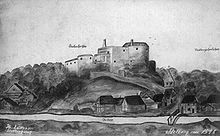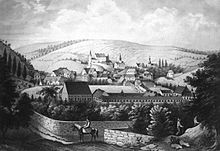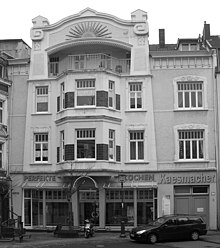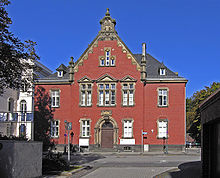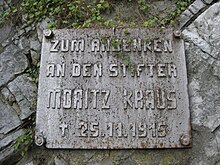History of the city of Stolberg (Rhineland)
History and chronicle of the west Rhine city of Stolberg (Rhld.)

HRR = Holy Roman Empire , Frk. = France
Stolberg's history is shaped by its location in the Voreifel in the narrow valley of the Vichtbach and its natural resources. Politically, Stolberg was limited to the lower Vichttal until the 20th century, while large parts of today's urban area belonged to the imperial abbey Kornelimünster , to Eschweiler or later to the independent communities Kornelimünster , Büsbach , Gressenich , Hastenrath and Roetgen . The history of these areas is only taken into account here insofar as it is relevant to Stolberg's overall development.
prehistory
The oldest traces of human settlement were found around 1965 near Büsbach on the forest-free Brockenberg. A culture layer with small devices from the early Mesolithic (around 10,000 BC) was discovered there. Other finds at Brockenberg and at Gut Tannenbusch date from the Neolithic Age (around 5,000 to 1,900 BC). Finds in Zweifall and Schevenhütte also suggest Stone Age places to stay.
Celts and Romans
In Stolberg, the names of the waters Inde , Vicht and Wehe come from the Celtic language . In the vicinity of the dam of the Wehebachtalsperre near Schevenhütte, the remains of a Celtic refuge from the Iron Age were found. Finds suggest that the brass and iron industry originated in today's urban area in the Celtic and Roman times. In Atsch, an iron smelter was excavated near a presumed battlefield, and there are also remains of Roman settlements, a burial mound and the remains of a Roman road from Aachen to Jülich . The Romans probably continued to operate the iron smelting facilities with Celtic workers and also took over from the Celts the process of producing the shiny gold brass from copper and calamine . Extensive slag heaps on the Breinigerberg and between Diepenlinchen and the Römerfeld in the Mausbacher Heide suggest metal smelting as early as Roman times. The Hemmoorer buckets found near Cuxhaven in a Germanic burial ground from the 2nd and 3rd centuries were probably made in the area around Gressenich and are therefore also called "Gressenicher buckets". Traces of settlement from Roman times, namely from the 1st to 3rd centuries AD, have been found on Brockenberg-Hassenberg. A branch line of the Roman road from Bavay (northern France) via Kornelimünster to Cologne ran via Dorff and Hassenberg southeast of Büsbach in the direction of Jülich. One suspects a Roman road watchdog on today's castle rock.
Middle Ages: 12th to 16th centuries
Stolberg was first mentioned in a document in 1118 , when Reinardus von Staelburg co-signed the founding deed of the St. Georgs Stift zu Wassenberg . The seat of the Lords of Stalburg was Stolberg Castle . In the 13th and 14th centuries, lords of the castle were a line of the von Salm-Reifferscheid family and then Reinhard II von Schönforst from today's Aachen district of Forst . Stolberg came to the Duchy of Jülich in 1396 . Until 1402, Duke Wilhelm III ruled . from Jülich the area. From 1402 to 1423 Duke Rainald von Jülich and Geldern ruled . Duke Adolf von Jülich and Berg ruled Stolberg between 1423 and 1437, before Duke Gerhard von Jülich and Berg took control, who pawned the area on July 13, 1445 to knight Wilhelm von Nesselrode . In the same century the dukes enfeoffed the family of those of Nesselrode with Stolberg, in the 16th and 17th centuries the family of those of Efferen with the subordination of Stolberg. According to J. Fabricius, Stolberg in the Jülich Duchy was "originally a castle and a knight's seat in the Eschweiler Office on the border with the Wilhelmstein Office and the area of the Imperial Abbey Kornelimünster on the other side of the Vichtbach ". The border between the two offices was marked by a small moat flowing into the Vichtbach. The part belonging to the Wilhelmstein office was called 'Berger Seite' and was subordinate to the Nothberg court . It included the Finkenberg. On February 28, 1644, the lord of the castle was again awarded the jurisdiction on the Berger side after years of disputes with the Wilhelmstein office and the Nothberg court after 1629 and this time definitely. Only the taxes should still be paid to the Wilhelmstein office. In 1777, due to an electoral edict, the Berger side was completely incorporated into the glory of Stolberg. Until 1789, the Stolberg glory remained in the family lines of the von Frentz and von Beissel families and formed its own subordinate rule in the Oberamt Jülich and Duchy of Jülich, which only extended from Binsfeldhammer to the confluence of the Inde and Vichtbach am Schnorrenfeld and spread over a territory of 318 ha stretched. To the north was the Jülich office of Eschweiler, which later became the office of Wilhelmstein, and to the east was the Jülich office of Wilhelmstein and Wehrmeisterei , which comprised the current districts of Schevenhütte and Zweifall (east of Vicht and Hasselbach, the rest of the town belonged to the Montjoie office ) and itself Gressenich and partly Vicht and Mausbach shared with the imperial abbey Kornelimünster , which stretched west and south of the subordinate rule Stolberg and also included the present-day Stolberg districts of Münsterbusch , Büsbach , Breinig , Dorff and Venwegen .
In 1324 the "village of Staylburg" was mentioned for the first time, whose annual interest amounted to 58 capons and 8 chickens. From the middle of the 15th century, craftsmen who smelted iron, copper, lead, gold and silver settled in the shadow of the castle. In 1496, the village of Stolberg is said to have consisted of only two to three houses and even in 1569 it only comprised eleven to twelve houses. The colored map which the artist Egidius Waschaple made in 1548 for a legal dispute between the lord of the castle and the abbot of Kornelimünster also shows only twelve houses and three mills. In addition to the subordination, a local community with a mayor developed - probably supported by the self-confidence of the copper masters - by the end of the 17th century, which can be seen as the beginning of local self-government in Stolberg. The first minutes of a mayoral election are available from 1738. At the end of the 18th century, the streets and alleys of the village were what was then the main street (today Burgstraße), the Katzhecke and the Enkerei.
Oldest brass city in the world
Around 1600 the lord of the castle of Effern allowed Protestant copper masters from Aachen to move to his area after they had fled from there due to the Aachen religious unrest. They brought with them knowledge of brass production , in which copper was alloyed with the local calamine or zinc blende and further processed using the water power of the Vichtbach. Since it was not yet clear about the role of zinc, which was only recognized as an element at the beginning of the 19th century, brass was also called "yellow copper". This is where the terms "copper master" and "copper city", which are still used today, come from. On the upper reaches of the Vichtbach and the Wehebach in Schevenhütte , the riding masters operated iron extraction and processing in today's Stolberg urban area. Some of their production facilities, the Reitwerke , are still preserved today ( Junkershammer , Neuenhammer , Platenhammer ). An economic upswing was initiated by the copper masters and riding masters. Stolberg was one of the few centers of brass production worldwide and had almost a monopoly position in Europe. Against this background, Stolberg likes to call itself the “oldest brass town in the world”. Numerous architectural monuments such as the copper courtyards still bear witness to this heyday of early industrialization . They not only served as production facilities, which were expanded as castles for troubled times, but with their splendid baroque-style expansion, they also demonstrate the upper-class representation will of the copper master families, which is also expressed almost aristocratically in family coats of arms. Furthermore, the Vogelsang Church was built in Stolberg in 1647 as the first Lutheran church on the left bank of the Rhine , while a Calvinist church was built on the Finkenberg . The copper master cemetery with numerous upper-class graves is located near her .
French period
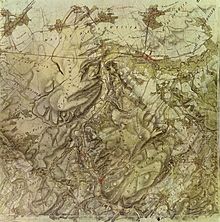
The French period is the epoch of French dominance and - also indirectly - rule over large parts of Europe between 1792 and 1815 after the French Revolution and the coalition wars , which temporarily influenced the entire German-speaking area. After Aachen was occupied by the French generals Desforest and Stengel, part of the troops under Fregeville Stolberg was occupied. The French were pushed back to the French border by the Austrians in the Battle of Aldenhoven , but then moved back into Stolberg via Münsterbusch in 1794 . The French appointed the citizen Hermann Peltzer general administrator. On behalf of the central administration in Aachen, he deposed the two mayors Johann Peter Schmitz and Heinrich Beckers and eight councilors. Later Johann Adam Schleicher was appointed mayor and the four citizens Laurenz Lynen Sohn, Johann Wilhelm Scheibler, Johann Graff and Johann Wilhelm Dahmen were members of citizens' councils. In 1795, Dahmen was then designated as Maire and Johann Haahs and Jakob Braun as assessors. While the area on the left bank of the Rhine belonged to France from 1794 to 1815, Stolberg formed a mairie , which, like the mairies Gressenich and Büsbach, belonged to the canton of Eschweiler in the Arrondissement d'Aix-la-Chapelle in the Département de la Roer , founded in 1801 . The continental barrier helped the Stolberg brass industry, which had been ailing since the second half of the 18th century, to take a break and to flourish. The Stolberg Chamber of Commerce existed from 1802 to 1931 .
Prussia and the Imperial Era
In 1815, after the fall of Napoleon , Stolberg fell to Prussia and in 1816 became a mayor's office . Conrad Esajas Michels became the first mayor. With almost 2,600 inhabitants in 334 houses, Stolberg was the smallest municipality in the Aachen district to which the city has belonged ever since. In addition, the district was assigned to the Aachen administrative district , which it was part of until it was incorporated into the Cologne administrative district in 1972. The administrative district of Aachen, and thus also Stolberg, came first to the Prussian province of the Grand Duchy of Lower Rhine , which was united with the province of Jülich-Kleve-Berg to form the Rhine province in 1822 . The two Protestant congregations did not merge into a Reformed congregation in Stolberg recommended by the Prussian King in 1817 until 1860.
In 1823, Stolberg received the Mühle district from Eschweiler . At today's Kaiserplatz, a new town hall in the classical style was built in 1837 .
When it joined Prussia, the Stolberg metal industry lost its French sales market and found itself in a difficult peripheral position, which, however , could be overcome through the use of modern techniques such as the steam engine and the newly developed zinc processing. Lead and above all zinc replaced brass as the most important metals in the Stolberg economy. In addition to the lead and zinc industries, the glass and chemical industries continued the diversification of the economy, which Mathias von Asten had initiated in 1719 with the start of cloth production in the Knautzenhof . As part of this structural change, the copper master families became manufacturers. Production shifted from the now cramped copper yards to larger, brick-walled factories. Industrialization was decisively advanced by the brothers John and James Cockerill . A "second seraing " was planned for Stolberg . In Münsterbusch and Mühle , one of the first industrial landscapes in Germany was created within the framework of the Aachen district .
Railway connection and city rights
In 1841 Stolberg was connected to the railway network and was given its own stop in the Eilendorfer area ("Stolberg Station"). With the construction of the Stolberger Talbahn in Vichtbachtal in 1867, 1881 and 1889, the railway connection of the Stolberg companies was improved and a connection to the Vennbahn was established. In 1888 the station with the name "Stolberg Bf." (Later "Stolberg Hbf.") Was built on Eschweiler territory.
Due to the Rhenish city regulations, Stolberg received the Prussian city rights on application in 1856, although it could not have the required 10,000 inhabitants, but became a member of the provincial parliament because of its commercial structure .
The upswing of industrialization was also reflected in the cityscape. Wilhelminian-style town houses and villas of the factory owners were built in Steinweg and Rathausstraße, while in the poor parts of the old town, such as B. Vogelsang, the lower class and the factory workers lived. In the second half of the 19th century, the evangelical mayor and lieutenant a. D. Friedrich von Werner and the Catholic pastor of St. Lucia Roland Ritzefeld to mitigate the social consequences of industrialization and to promote the modernization of Stolberg outside the economy. At the instigation of Ritzefeld, the parish of St. Lucia set up the Bethlehem Hospital in the former Steinfeld copper yard in 1866 .
In 1888 the industrialist Moritz Kraus bought Stolberg Castle and had it rebuilt in its current form.
At the turn of the century, a district court , a main post office and the Goethe Gymnasium were built on Kaiserplatz , and the Grüntal elementary school in the immediate vicinity. A statue of Emperor Wilhelm I from 1897, which gave Kaiserplatz its name to this day, was removed by the Allied occupation forces after the First World War . The parish church of the Assumption of Mary and the elementary school on Herrmannstrasse were built in the Unterstolberg / Mühle district. In 1913, the areas Schneidmühle and Jordansberg zu Stolberg came from the municipality of Büsbach .
Weimar Republic: Democratization
As a result of the Peace Treaty of Versailles , Stolberg was occupied by Allied troops of Belgians and French from 1919 to 1929 ( Allied occupation of the Rhineland ). Like the rest of the Rhineland, he was spared the civil war-like turmoil at the beginning of Weimar democracy. In Büsbach, the population ended a separatist interlude. The establishment of the Weimar Republic meant that the mayors were no longer appointed from above, but were elected by the city council. The Prussian three-class suffrage was given up in favor of the same suffrage, which women could for the first time exercise both actively and passively. The critical circumstances of the period of inflation caused the city to issue emergency money together with neighboring Eschweiler.
In the mid-1920s, 1,800 of the 17,000 inhabitants in Stolberg were unemployed. The city sought to find work by building workers' housing on the outskirts. In 1920 the Hammerberg area and in 1932 the Burgholzer Hof, Niederhof, Hochweger Hof and Steffenshof were incorporated into the municipality of Hastenrath , the so-called " Hastenrather Zipfel ". In 1930 the Stadtbad in Grüntalstrasse was inaugurated.
time of the nationalsocialism
In Stolberg, too, the end of the Weimar Republic was marked by clashes between democratic and radical parties. The KPD , which got the most votes in Vogelsang and whose meeting point was the former Hotel Scheufen, became twice as strong as the SPD in the local elections in 1929 with six seats on the city council. The NSDAP did not succeed in making the leap to the city council. It was only at the time of the Great Depression that it was able to record increased election successes. At the end of 1931, due to an order of the Cologne-Aachen Gauleitung , Stolberg became the seat of the NSDAP district leadership for the Aachen district, while local groups remained in the surrounding cities. At the corner of Schellerweg and Rathausstrasse (Rathausstrasse 49) stood the so-called 'Brown House', and 'Haus Metropol' became the seat of the “West German Observer”. In the local elections with a voter turnout of 74.4% on March 12, 1933, the center won ten seats (minus two), the NSDAP nine (plus nine), KPD four (minus two), SPD three (unchanged), the battle front Schwarz -white-red one, and the Prehlerpartei (an association of small retailers and craftsmen) one. Seven city councilors as well as the elected representatives of the Black-White-Red and the Prehler Party joined the NSDAP as interns; the center member Christine Büngens did not accept the election, as did the two KPD members Reinhard Schirbach and Juliane Decker. According to the circular issued by the Minister of the Interior on March 20, 1933, no substitute members were allowed to replace them. This circular also prevented the elected councilors Peter Winterich and Jakob Radermacher from assuming their mandates for the KPD. By July 14, the Social Democrat August Meurer and the center MPs Claus Robert, Matthias Souren and Louis Hülsen resigned their city council mandates. Ludwig Lude of the SPD was not allowed to move up due to a circular issued by the Interior Minister on June 23, the other Social Democrats were not allowed to take up their seats at all. High-ranking representatives of the center lost their jobs in the city administration and in the school system. Unsolicited, the head of the city library removed literature that the regime did not like. The Hitler Youth burned books in public. On April 1, 1933, the SA also called for a boycott of Jewish shops in Stolberg. On May 1, 1933, the city council decided on extensive name changes: The Goethe-Gymnasium was henceforth called "Städtisches Langemarck-Gymnasium" (canceled in 1945), Neustraße (today's Salmstraße) Hindenburgstraße, Oststraße Bismarckstraße, Hastenrather Straße Horst-Wessel- Straße . Steinweg and parts of Aachener Strasse were renamed Adolf-Hitler- Strasse . The Reich President Hindenburg and Adolf Hitler as Reich Chancellor were granted honorary citizenship. Walther Dobbelmann (DNVP), mayor from 1906 to 1934, applied for his retirement under pressure from the NSDAP, which took place on October 1, 1934. Anton Braun, head of the Gaurevisions department, acted as mayor in Stolberg. Engelbert Regh (NSDAP), from 1945 to 1955 for the FDP in the city council and district council, was introduced as mayor by the regional president Eggert Reeder on February 25, 1935 with the approval of Gauleiter Grohé . According to the German municipal code, the city council lost its decision-making powers to the mayor, and the councilors were appointed for six years.
After the First World War, a stone memorial was erected in Stolberg for the fallen soldiers with a kneeling bronze figure, which the National Socialists probably added another standing figure. After the Second World War , the group of figures was removed and replaced by an iron cross made of stone, which was relocated to Ellermühlenstraße. In 1932, a memorial for those who died in World War II with a naked, neoclassical bronze figure, the base of which bears the inscription “I had a comrade” (artist: Walther Wolff from Berlin), was erected at the Bergstrasse cemetery , thanks to a private donation. Nearby is a square memorial to the numerous victims of an explosion in the Schippan fertilizer factory in Atsch in 1920. On May 1, 1933, the municipal grammar school and four streets were renamed in line with National Socialist ideology. The newly built Mühlen Bridge was inaugurated on October 30, 1937 as the "Heinrich Heimes Bridge", named after a 17-year-old Stolberg high school student who died on the Eastern Front in 1914 and who volunteered at the age of 16.
In 1935 the urban area was expanded, which also increased the population by 11,000: Stolberg received the districts of Donnerberg , Duffenter , Birkengang , Velau , Steinfurt with the Stolberg main station and the southwest of the Propsteier Forest ( Steinbachshochwald ) from Eschweiler . This was around 500 hectares with around 1,400 inhabitants and two disused zinc smelters. In addition, Stolberg received Atsch von Eilendorf in the west and the municipality of Büsbach , which had 9,000 inhabitants and included the districts of Büsbach, Dorff , Münsterbusch and Kohlbusch .
In 1938 the pogrom night of the neighboring towns was organized in Stolberg . On November 9, 1938, the SA and SS that had gathered at the Alter Markt devastated the two remaining Jewish shops in Stolberg: the shoe shops Bernhard Wächter and Sigmund Zinader. As a result, a city order forbade Jews to visit the city pool and library and to use public park benches. The prayer room behind Haus Steinweg 78 was closed at the beginning of 1939. Jewish shops, such as Berthold Wolff's textile shop in Steinweg, were "Aryanized" . The small Jewish community , which in 1933 still had 76 members, dissolved completely through flight and deportation . Two non-Jewish men saved their Jewish wives' lives because they did not divorce. There is evidence that at least 19 Stolberg Jews were murdered during the Nazi regime or disappeared in the vicinity of the “extermination camps” in the east. Stolberg communists and apolitical critics of the regime were also killed in concentration camps and other camps. The Social Democrat Ludwig Philipp Lude , the non-party trade unionist Mathieu Wilms, Peter Spiegelmacher and Paul Arentsen organized illegal SPD party cells. Resistance also came from the Catholic milieu through Pastor Fritz Keller and Chaplain Joseph Dunkel.
Forced Labor and Deportation

The metalworking industry, especially the Prym and Stolberger Metallwerke companies , switched to armaments production during World War II. Forced laborers , who were housed in barracks close to production, not only replaced the drafted workers from industry, but also ensured the fulfillment of major orders for armaments. According to the EBV , the Stolberg industry with around 2,500 forced laborers (including 600 prisoners of war) was the largest place of work for forced laborers in the Aachen district .
In June 1944, three months before the arrival of the American troops in Stolberg, the number of forced laborers reached its peak with over 2,200 forced laborers and 800 prisoners of war. The proportion of foreign workers in the industrial and manual trades in Stolberg was 40% at that time (Reich average 29%). In total there were at least 38 larger forced labor and prisoner of war camps in the entire city area.
In November 1941, the Gestapo set up a camp for 121 Jewish slave laborers on the premises of Kali Chemie AG on Rhenaniastrasse, who until June 1942 had to do twelve hours a day of slave labor in the neighboring factories and were subjected to harassment by the supervisors.
In the summer of 1942 there was a transit camp in the RAD barracks in Mausbach , where around 300 Jews had to wait under inhumane conditions for their deportation. During the Second World War, William Prym employed around 500 inmates of the prisons in Cologne and Aachen in what is known as home work. At the same time, East European forced laborers were assigned to the Stolberg industry in large numbers. In June this year which brought Zinkhütte Münsterbusch 106 men at its premises in the Cockerillstraße under which Dalli-Werke 42 women and the shares spinning 20 women. On July 29, 1942, the United Glass Works in Stolberg quartered 68 men in a camp on their premises. From August 1942, 22 externally housed women at Kerpen & Co. and Stolberger Metallwerke , and 28 equally localized men at William Prym, had to do forced labor. After the deportation of the Jewish inmates, prisoners of war who were forced to do forced labor were also held at almost all locations and in the camp on Rhenaniastrasse. The company fire brigade was considered to be the “works SS ” because of the mistreatment it had committed .
On April 25, 1944, three Polish youths were executed by the Aachen Gestapo near their camp at Stolberg train station in front of numerous German witnesses and guests, as well as hundreds of Polish slave laborers, for allegedly stealing some food from a wagon at Aachen Westbahnhof . A total of 52 forced laborers died in Stolberg, including one of six farm workers in what was then the urban area, who died on December 16, 1942 on a farm in Büsbach - in line with the recommendations of the Rhineland regional farmers' union - due to alleged lack of work performance due to refusal to eat. On March 2, 1943, five Roma families (37 people in total) were deported from Stolberg to the Auschwitz-Birkenau concentration camp. A total of 152 to 177 people lost their lives as a result of the Nazi regime in Stolberg.
On January 20, 2001, a memorial in the form of a swastika forged from barbed wire was inaugurated on the site of the former Zinkhütter Hof to commemorate the victims of National Socialism. It was forged by the blacksmith Matthias Peters on the initiative of former SPD councilor Matthias Breuer and financed by donations from private individuals and companies. The handicraft work is considered controversial, as the chairman of the Jewish Central Council Paul Spiegel was deeply shocked during a tour of the swastika shape. At the corner of Rhenaniastraße and Münsterbachstraße, a memorial stone with a Star of David was inaugurated in Berthold Wolff-Park , which commemorates the camp on Rhenaniastraße and especially mentions the Jewish slave laborers. At the train station a memorial in the form of a wheel with the inscriptions “Forget not” and “Mabister” (in Romanés ) was erected, which is supposed to commemorate the deportation of the Sinti and Roma from Stolberg and name the victims. At the invitation of the city of Stolberg, former forced laborers from Eastern Europe came to Stolberg in 2000, where, among other things, they reported on their experiences at schools and received small material benefits.
Allied occupation at the end of the Second World War
Tunnels under the castle and on Zweifallerstraße were used for air protection. Even before the Allied conquest of Aachen on October 21, 1944, American troops advanced to Stolberg and Schevenhütte on September 12, 1944 . The fighting over this so-called " Stolberg Corridor " brought destruction and inflicted great suffering on the civilian population. The mayor largely ignored evacuation orders from the Nazi authorities. About 10,000 people stayed behind in Stolberg. A passenger train with numerous evacuees from Stolberg was caught in a British low-flying attack near Jülich . Stolberg was not fully occupied until September 20th after fierce fighting. Since the front remained nearby, the disruptions caused by fighting ended only after the fall of Eschweiler in November 1944. The top city officials appointed by the Americans (Mayor Friedrich Deutzmann), in particular the deputy mayor Ludwig Philipp Lude , began to denazify the city administration. At the end of the Second World War, Marlene Dietrich came back to Germany with the first American troops and was recognized by a German at the Stolberg train station and, to her great surprise, welcomed with joy.
post war period
After the Second World War, Stolberg became part of the British zone of occupation and has belonged to the state of North Rhine-Westphalia since 1947. Refugees and displaced persons from eastern Germany built the Donnerberg settlement with stones that they had broken themselves . A new building area for refugees and displaced persons was also built in Velau . After the Second World War, memorials for the victims of war and violence were built near the church in some parts of the city, such as in Zweifall and on Donnerberg . In 1956 the new building of the Bethlehem Hospital was inaugurated and a new vocational school building was opened. The sponsorship of the various vocational, technical and commercial schools grouped there passed from the city to the district in 1970. The construction of the town hall (officially opened on November 25, 1961) and the redevelopment of the area around the Bastinsweiher, which also fell victim to the Kupferhof Ellermühle, were important stages in the inner-city development. The city was present in the media across Germany in the 1960s through the drug Contergan produced by the pharmaceutical company Chemie Grünenthal GmbH based in Stolberg, which was founded in 1845 from a soap factory ; the hearings and trials in the so-called Contergan scandal, however, took place in Aachen , the company's headquarters, and in Alsdorf . The notification of health by Stolberg children, the so-called lead children , and livestock grazing by heavy metals, the so-called Gressenicher disease , was after 1965 the impetus for environmental efforts . In the course of the 1960s, Stolberg grew in a kind of 'head-to-head race' with Eschweiler to become one of the most populous communes in the Aachen district.
After the municipal territorial reform in 1972
At the end of the 1960s, a quarter of the pupils at the Goethe Gymnasium and a third of the girls at the girls’s grammar school were foreigners. During the communal territorial reform on January 1, 1972, the city area experienced a considerable expansion to the south-east in accordance with the wishes of the administration and thus tripled again. Responsibility for the district court was transferred to the district court of Eschweiler on April 1, 1973 . In the 1970s, the new town hall was built next to the old town hall on Kaiserplatz, as well as the Glashütterweiher stadium and indoor pool.
In the 1980s, the renovation of the heavy metal dumps was largely completed and the Oberstolberg old town restored. The Steinweg was designated as a pedestrian zone in 1987 and the Salmstraße was traffic-calmed.
The number of asylum seekers to be looked after by the city of Stolberg soared from 131 in the previous year to 562 in 1990.
In 1988 a memorial plaque was set in the ground in front of the former prayer room of the Jewish community in Steinweg on the occasion of the 50th anniversary of the Reichspogromnacht . A park on Rhenaniastraße was renamed Berthold Wolff -Park in memory of the Jewish textile merchant of the same name . Catholic resistance fighters honored the naming of Kaplan Dunkel-Platz in the Unterstolberg district and the Liester secondary school as the Provost Grüber School . The town hall forecourt is called Ludwig Philipp Lude- Platz after the social democratic resistance fighter and later the first regional president of the district of Aachen after the Second World War .
In the 1990s, a new central cemetery was set up in Buschmühle, and the Zinkhütter Hof museum opened as an industrial museum in 1996. Furthermore, the L 238n was completed as a city center bypass. The Münsterbusch service center and the Steinfurt industrial park were handed over to their destination. In 1998 the administration of the ERA moved into the converted building of the Ketschenburg brewery .
Stolberg in the 21st century
In 2001 the Euregiobahn went into operation with new and renamed stops and has since opened up the Stolberg city center on tracks for public transport. In 2004 Stolberg bought a southern piece of the Propsteier forest from the city of Eschweiler in order to set up a new industrial area for small businesses on the former military site of Camp Astrid .
In September 2006, the city celebrated “ 150 years of city charter ”. On this occasion, the Sparkasse Aachen minted a silver commemorative medal.
With the amalgamation of the district and city of Aachen in September 2009, Stolberg is one of the ten municipalities in the new Aachen city region .
During the harsh winter, the roof of a riding hall collapsed on December 25, 2010 in the Mausbach district and the roof of a sawmill in the Zweifall district.
Overview of the area and population development
- Early modern times: Herrlichkeit, Marie and Mayor's Office Stolberg 318 ha
- 1823 Incorporation of the Mühle district (today Unterstolberg) of Eschweiler
- 1913 Schneidmühle and Jordansberg from the municipality of Büsbach
- 1920 the Hammerberg area from the municipality of Hastenrath
- In 1925 the urban area covers 456 hectares (with around 17,000 inhabitants).
- 1932 Incorporation of the so-called Hastenrather Zipfels (Burgholzer Hof, Niederhof, Hochweger Hof and Steffenshof, a total of 268 hectares) by the municipality of Hastenrath
- 1935 Incorporation: The urban area triples to 2,890 ha:
- Donnerberg , Duffenter, Birkengang, Velau , Steinfurt and the southwest of the Propsteier Forest (Steinbachshochwald) (around 500 ha area) from Eschweiler
- Atsch from Eilendorf
- Municipality of Büsbach with the districts of Büsbach, Dorff , Münsterbusch and Kohlbusch
- 1972 Incorporation as part of the municipal regional reform:
- Community of Gressenich 41.1 km², 9,415 inhabitants
- Vicht , Breinig , Venwegen (from Kornelimünster ) 17 km², 5,343 inhabitants
- Zweifall (von Roetgen ) 10.8 km², 2,030 inhabitants
- 1972 Boundary corrections: Bayerhaus at Aachen and area near Steinfurt at Eschweiler
- 2004 Purchase of a southern part of the Propsteier Forest in Eschweiler
| date | source | population |
|---|---|---|
| 16th Century | estimate | at 150 |
| 1610 | count | 78 "honorable feudal people" |
| Late 17th century | estimate | around 600 |
| 1794 | count | 1,540 in 270 houses |
| 1800 | Count in the French department | 1,900 |
| 1816 | - | 2,583 |
| 1825 | - | 3,076 |
| 1849 | - | 4,457 |
| 1856 | - | 6,581 |
| 1885 | - | 11,835 |
| 1905 | - | 14,963 |
| 1925 | - | approx. 17,000 |
| 1935 | - | 30,215 |
| 1939 | census | 29,511 |
| 1950 | census | 31,742 |
| January 1, 1956 | - | 35,512 |
| 1961 | census | 37,462 |
| December 31, 1971 | before the municipal reorganization | 40,566 |
| January 1, 1972 | after the municipal reorganization | 57,266 |
| 1987 | census | 55,747 |
| January 1, 2002 | City administration | 60.286 |
| December 31, 2005 | City administration | 58.023 |
Economic history
Ores and the resulting iron, zinc, lead and brass processing industries shaped the economic structure of Stolberg for centuries . The copper masters left their mark on the city. Glass-producing plants, "chemical companies" and, recently, an increasing number of services are additional pillars.
Individual evidence
- ↑ Offergeld-Thelen, Beate, The development of the local community of Stolberg taking into account the relationship to the Unterherrschaft Stolberg, Diss. Bonn 1983.
- ↑ Forced labor in the border zone. The Aachen district during World War II ( Memento of the original from September 27, 2007 in the Internet Archive ) Info: The archive link was inserted automatically and has not yet been checked. Please check the original and archive link according to the instructions and then remove this notice. . by Thomas Müller. Aachen 2003. Print version of a study commissioned and financed by the Aachen district at RWTH Aachen University: Forced labor in the Aachen district, edited by Thomas Müller, Aachen 2002.
- ↑ Thomas Müller: Forced Labor in the Border Zone : The Aachen District in World War II, Aachen 2003
- ↑ Klara van Eyll : From the copper yard to pharmaceutical research. The Grünenthal farm and the Wirtz family. In: the scales. Magazine of Grünenthal GmbH, Aachen. Volume 35, 1996, number 2 (pp. 45-88), pp. 48-57, here: pp. 48-50.
- ↑ Martin Bünermann, Heinz Köstering: The communities and districts after the municipal territorial reform in North Rhine-Westphalia . Deutscher Gemeindeverlag, Cologne 1975, ISBN 3-555-30092-X .
- ↑ http://www.pressglas-korrespondenz.de/aktuelles/pdf/pk-2000-1w-garcke-stolberg-siegwart.pdf Glass from Stolberg
